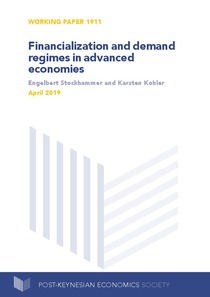Financialization and demand regimes in advanced economies
"In this article, we analyze the implications of financialization for domestic demand formation by linking the concept of financialization to the post-Keynesian analysis of demand regimes. We examine how the financialization of households in advanced economies gave rise to distinct but interdep...
| Main Authors: | , |
|---|---|
| Institution: | ETUI-European Trade Union Institute |
| Format: | TEXT |
| Language: | English |
| Published: |
Leeds
2019
PKES |
| Subjects: | |
| Online Access: | https://www.labourline.org/KENTIKA-19308456124911266389-Financialization-and-demand-re.htm |
| Summary: | "In this article, we analyze the implications of financialization for domestic demand formation by linking the concept of financialization to the post-Keynesian analysis of demand regimes. We examine how the financialization of households in advanced economies gave rise to distinct but interdependent demand regimes. In the Anglo-Saxon and southern European countries, financialization in the form of property price inflation and rising household debt contributed to the development of a debt-driven demand regime with large current account deficits. Economic development in eastern Europe was shaped by catching-up through foreign direct investment from northern Europe and accompanied by worsening current account positions. Northern Europe, in contrast, relied on an export-driven demand regime with a weaker role for financialization. The export-driven demand regime relies on the financialization of southern Europe and the Anglo-Saxon countries, which helped create export demand for northern Europe. We argue that this constellation of demand regimes gives rise to divergent economic performance and macroeconomic instability. While with deleveraging the growth effects of the debt-driven model have gone into reverse, the fundamental configuration has not changed since the crisis." |
|---|---|
| Physical Description: | 16 p. Digital |

